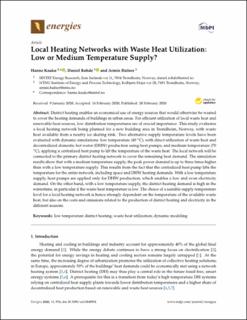| dc.contributor.author | Kauko, Hanne | |
| dc.contributor.author | Rohde, Daniel | |
| dc.contributor.author | Hafner, Armin | |
| dc.date.accessioned | 2020-08-21T08:39:49Z | |
| dc.date.available | 2020-08-21T08:39:49Z | |
| dc.date.created | 2020-02-24T10:47:41Z | |
| dc.date.issued | 2020 | |
| dc.identifier.citation | Energies. 2020, 13 (4), . | en_US |
| dc.identifier.issn | 1996-1073 | |
| dc.identifier.uri | https://hdl.handle.net/11250/2673342 | |
| dc.description.abstract | District heating enables an economical use of energy sources that would otherwise be wasted to cover the heating demands of buildings in urban areas. For efficient utilization of local waste heat and renewable heat sources, low distribution temperatures are of crucial importance. This study evaluates a local heating network being planned for a new building area in Trondheim, Norway, with waste heat available from a nearby ice skating rink. Two alternative supply temperature levels have been evaluated with dynamic simulations: low temperature (40 °C), with direct utilization of waste heat and decentralized domestic hot water (DHW) production using heat pumps; and medium temperature (70 °C), applying a centralized heat pump to lift the temperature of the waste heat. The local network will be connected to the primary district heating network to cover the remaining heat demand. The simulation results show that with a medium temperature supply, the peak power demand is up to three times higher than with a low temperature supply. This results from the fact that the centralized heat pump lifts the temperature for the entire network, including space and DHW heating demands. With a low temperature supply, heat pumps are applied only for DHW production, which enables a low and even electricity demand. On the other hand, with a low temperature supply, the district heating demand is high in the wintertime, in particular if the waste heat temperature is low. The choice of a suitable supply temperature level for a local heating network is hence strongly dependent on the temperature of the available waste heat, but also on the costs and emissions related to the production of district heating and electricity in the different seasons | en_US |
| dc.language.iso | eng | en_US |
| dc.publisher | MDPI | en_US |
| dc.rights | Navngivelse 4.0 Internasjonal | * |
| dc.rights.uri | http://creativecommons.org/licenses/by/4.0/deed.no | * |
| dc.title | Local Heating Networks with Waste Heat Utilization: Low or Medium Temperature Supply? | en_US |
| dc.type | Peer reviewed | en_US |
| dc.type | Journal article | en_US |
| dc.description.version | publishedVersion | en_US |
| dc.source.pagenumber | 16 | en_US |
| dc.source.volume | 13 | en_US |
| dc.source.journal | Energies | en_US |
| dc.source.issue | 4 | en_US |
| dc.identifier.doi | 10.3390/en13040954 | |
| dc.identifier.cristin | 1796900 | |
| dc.relation.project | Norges forskningsråd: 280994 | en_US |
| dc.description.localcode | c 2020 by the authors. Licensee MDPI, Basel, Switzerland. This article is an open access article distributed under the terms and conditions of the Creative Commons Attribution (CC BY) license (http://creativecommons.org/licenses/by/4.0/). | en_US |
| cristin.ispublished | true | |
| cristin.fulltext | original | |
| cristin.qualitycode | 1 | |

